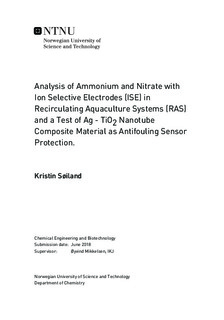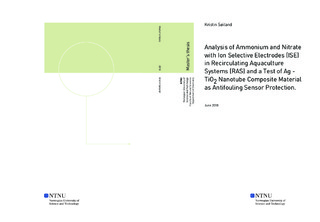| dc.description.abstract | Keeping salmon farming in closed recirculating systems, the challenge related to salmon lice, escape and leakage of nutrients will be dramatically reduced. A high content of nitrogen species deriving from nutrients and excrements can cause formation of ammonia, that is toxic for salmon. The industry demands fast and reliable analysis of these species. In this master thesis, the use of HACH ion selective electrodes (ISE) for nitrate (ISENO3181) and ammonium (ISENH4181) have been tested. Two tests were done in a recirculating aquaculture system (RAS) at Nofima in Sunndalsøra with 12 salinity, where challenges related to interfering ions and biofouling were investigated. One experiment with no antifouling treatment, and one experiment where vibration and a nylon filter was used as antifouling treatment was done. In addition to the RAS experiments, a flow through system (FTS) with fresh water was used to test a composite material of TiO2 nanorods with silver nanoparticles attached (PDMS-TiO2/Ag) as antifouling sensor protection. The release of silver ions from the silver particles was investigated adding a PDMS-TiO2/Ag coated Teflon cap to a brackish water solution. The silver concentration was determined by inductively coupled plasma mass spectrometry (ICP-MS). Samples from the RAS and FTS were also analyzed by ICP-MS to investigate eventual accumulation of metals. The samples were also analyzed by ion chromatography (IC) to quantify the ammonium and nitrate content compared to the ISE measurements. None of the metals in RAS or FTS exceeded the background levels for Norwegian coastal waters. There was found an accumulation of Zn and Cu in the RAS with a slope of 0.38 and 0.02 μgL−1day−1 respectively. Drift due to biofouling occurred in all experiments. In RAS the biofouling process started already after the first day. In the FTS the biofouling was visible after two weeks. When the ISE and IC results were compared, the presence of interfering ions was most significant in RAS. The NH4+ electrode was more affected by the salinity change in RAS than the NO3 electrode. The use of vibration and a nylon filter protecting the sensing elements, resulted in a more stable drift successively estimated using baseline reduction by minimum least squares regression (MLR). The PDMS-TiO2/Ag coated caps did not have a visible antifouling effect. In the experiment where the release of Ag+ was investigated, the increase was significant with a p-value equal to 0.012 for the two beakers with coated caps compared to p=0.11 for two blank tests. To achieve an antifouling effect, the cap design needs to be improved. In the FTS the ISE did detect small variations in the ammonium concentration as a result of the salmons daytime activity. The method was fast and effective in the freshwater system. More tests regarding antifouling and the presence of interfering ions need to be done to fully elucidate ISEs potential in aquaculture. | |

